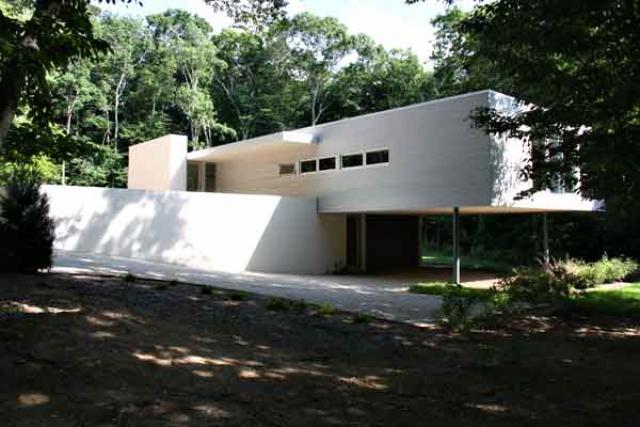A Reno Becomes a Redo

When Don Lenzer and Bettina Volz set out to renovate their aging quasi-saltbox in the almost rain forest-dense Amagansett woods north of Montauk Highway, a search led them across the country to a completely different landscape, the desert inferno of Phoenix, and a company called ASUL, which stands for Adaptable System for Universal Living. In other words, a “mass customization of homes,” if that isn’t an oxymoron — flexible and relatively affordable. These are no 2-by-4 balloon-frame structures that arrive on a flatbed, but rather seamless, geometric 21st century houses, steel-framed, and of technologically advanced materials put together with energy efficiency in mind. The couple had originally planned a “radical renovation” of their roughly 25-year-old house, Mr. Lenzer said. An ASUL representative took a look at the plan, drawn up by Frederick Stelle’s firm, pronounced it “nice,” then looked again and said the company could build them an entirely new house for the same price or less, still using a Stelle layout. “We jumped at the offer to build new, so we started a design process,” Mr. Lenzer said. Their concept called for something that was well designed, within a reasonable budget, and sustainable, “and all are interrelated.” Mr. Lenzer has been the director of photography on numerous documentary films, including “Into the Arms of Strangers: Stories of the Kindertransport,” which was produced in 2000, and has been a cinematographer dating back to his work on the 1970 film “Woodstock.” “We wanted it to be midcentury modern. I’m from Southern California, where it’s simply in the air.” He and Ms. Volz admire Arts & Architecture magazine’s famous Case Study Houses of the postwar years, the sleek work of commissioned architects like Charles and Ray Eames and Eero Saarinen, among others. Ms. Volz, a clinical psychologist who keeps an office in Bridgehampton, is a native of Germany and a fan of the modernist Bauhaus movement. Mr. Lenzer is also inspired by Rudolph Schindler, an Austria-born architect who worked in Los Angeles, and by “the levels and complex angles” of his houses. “Though this looked more like the Farnsworth House at first,” he said of Ludwig Mies van der Rohe’s 1951 lightbox of a domicile in Illinois, one long room on an elevated concrete slab, ahead of its time and influential, if not entirely livable. At this point Mr. Stelle, the veteran South Fork architect, whose firm is now Stelle Lomont Rouhani in Bridgehampton, “trotted out a sketch," a joint effort of his firm, "and it was an instant hit. . . . It’s an open plan, simple, clean, but still within proportion of the human scale.” Standing at one end of the living area, with its media wall and gas fireplace and mantel holding Le Corbusier and Bauhaus books and a couple of handmade pieces of pottery, you can see clear across the dining table and granite-topped island in the kitchen to the Bosch stove and on through to a screened-in porch — a second place to eat (a Weber grill stands in the corner) or to just take in the night air. “That wasn’t the architects’ favorite thing,” Mr. Lenzer said, but a concession to comfort. “We love this house now; we’re enjoying living in it. It’s not too austere or minimal; this is very functional.” Leaving the large main room, you pass through a hallway made useful by a washer and dryer hidden in cabinetry and even a Lenzer-designed foldaway ironing board. Off to one side there’s an office with a sleeper couch, where the only thing that comes close to a lament has to do with too few bookshelves. “I go to the library more now,” Mr. Lenzer said. In a nod to financial constraints, those bookshelves, the dressers, and the cabinets are all from Ikea. “The architects designed it with Ikea in mind. The cabinets are made to look custom made.” And then comes the most dramatic of the house’s sections. (“The builder calls them modules,” Mr. Lenzer said, “it has to do with space relationships.”) The bedroom is cantilevered and extends on poles out over the car park. It offers a vertiginous view as the world falls away, and then drops again where the backyard dips into a sizable kettlehole. From the bedroom you can step out onto a narrow mahogany deck that runs the length of the south side of the house. Mr. Lenzer, a helpful, enthusiastic sort, dug out a tape measure and set about getting an exact measurement — 87 feet. (The house itself amounts to about 2,600 square feet on a two-acre lot.) The deck’s metal railing, strung with steel wire and reminiscent of what you would see on a sailboat, is mirrored in the railing above the stairs down to the lower level, where there’s another office and a second bedroom. The concrete steps recall the concrete floating steps at the house’s entry. “You’ll notice there’s very little fenestration on the north side,” and in contrast, nothing but on the south. That orientation and the rectilinear shape gather in the sunlight. “There was a virtue in every necessity,” he said. What’s more, “The 10-kilowatt solar panel array on the roof gives us more than 100 percent of our electrical need.” “This is no grandiose house,” Mr. Lenzer said. “I think the architects appreciated keeping the size appropriate to the need.” He described a collaborative, friendly working relationship with the young and “quite international” team, headed up by Viola Rouhani, born in Sweden, as partner in charge. Luca Campaiola, from Italy, was the lead designer, and Esra Unaldi, who is Turkish, was concerned with sustainability. “For us nothing’s been more exciting than this project in the last couple of years,” Mr. Lenzer said.
